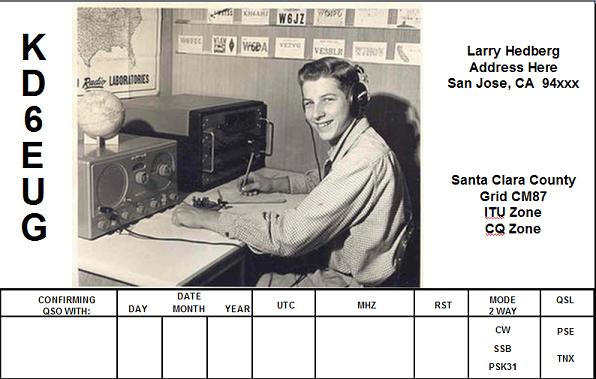My dad has recently upgraded to General and has been getting on the air making contacts. This isn’t the first time he’s been on HF or exchanged QSL cards. Back in his younger days, he held the call KN6ILL (I Love Lucy) and operated an HT-20 transmitter and a National NC-57 for a receiver with an 80 meter dipole. His license lapsed but now he is back in the game with an IC-718. He is making regular contacts using PSK-31 and has started to receive QSL cards. But he hasn’t made up his own cards yet. I figured I’d try an help with a rough draft – something to get the creative juices flowing.

Wikipedia defines a QSL card as a written confirmation of either a two-way radiocommunication between two amateur radio stations or a one-way reception of a signal from an AM radio, FM radio, or television station. A typical QSL card is the same size and made from the same material as a typical postcard, and many are sent through the mail as a standard postcard. QSL cards derived their name from the Q code “QSL”, which means “I acknowledge receipt.”
I really enjoy QSL cards, both receiving them in the mail from other hams verifying our QSOs and designing my own to send out as an acknowledgment of the contact on my end.
The appearance of your QSL card can be important for many. It gives the recipient a snapshot of you… and I find it difficult to do that on the small area provided by a 3.5″ by 5.5″ card.
The general agreed upon minimum elements of a QSL card are the following:
– Your callsign
– Basic information concerning the QSO
+ the other party’s callsign
+ time/date of contact in UTC/GMT/Zulu
+ band or frequency of the QSO
+ mode (SSB/CW/digital mode)
+ signal report (RST)
– Your name and mailing address
Additionally most hams include the following information which is useful for a number of different awards:
– County (for the county hunters)
– Grid (for the grid hunters)
– ITU and CQ zones
After that the door is wide open on what is found on a QSL card. Many include membership numbers which go towards earning awards (FISTS, SKCC, 10-10, etc.). Some also include one or more logos of clubs and organizations they belong to (ARRL, ARES, MARS, SKYWARN, contest club, local club, etc.).
Many hams like to individualize their QSL cards with a picture showing their hamshack, antenna farm, QRP rig, mobile setup. Others put a picture of a some notable location or landmark near where they live (National Park, major league stadium, civil war battlefield, etc.). And a few portray an additional hobby they are active in beyond (or complimenting) ham radio. This is where you can really set your card apart from others, make it stand out in a crowd.
I think some sound advise is to keep the card relatively clean and simple – don’t try to do too much in such a small space. Have fun and make your card something you are proud to share with others.
Here are some other sites with more information on QSL cards:
– eham.net: QSL Cards
– WA7S: QSL Cards – How to Make Your Own
– QSL Factory
– The QSL Man
